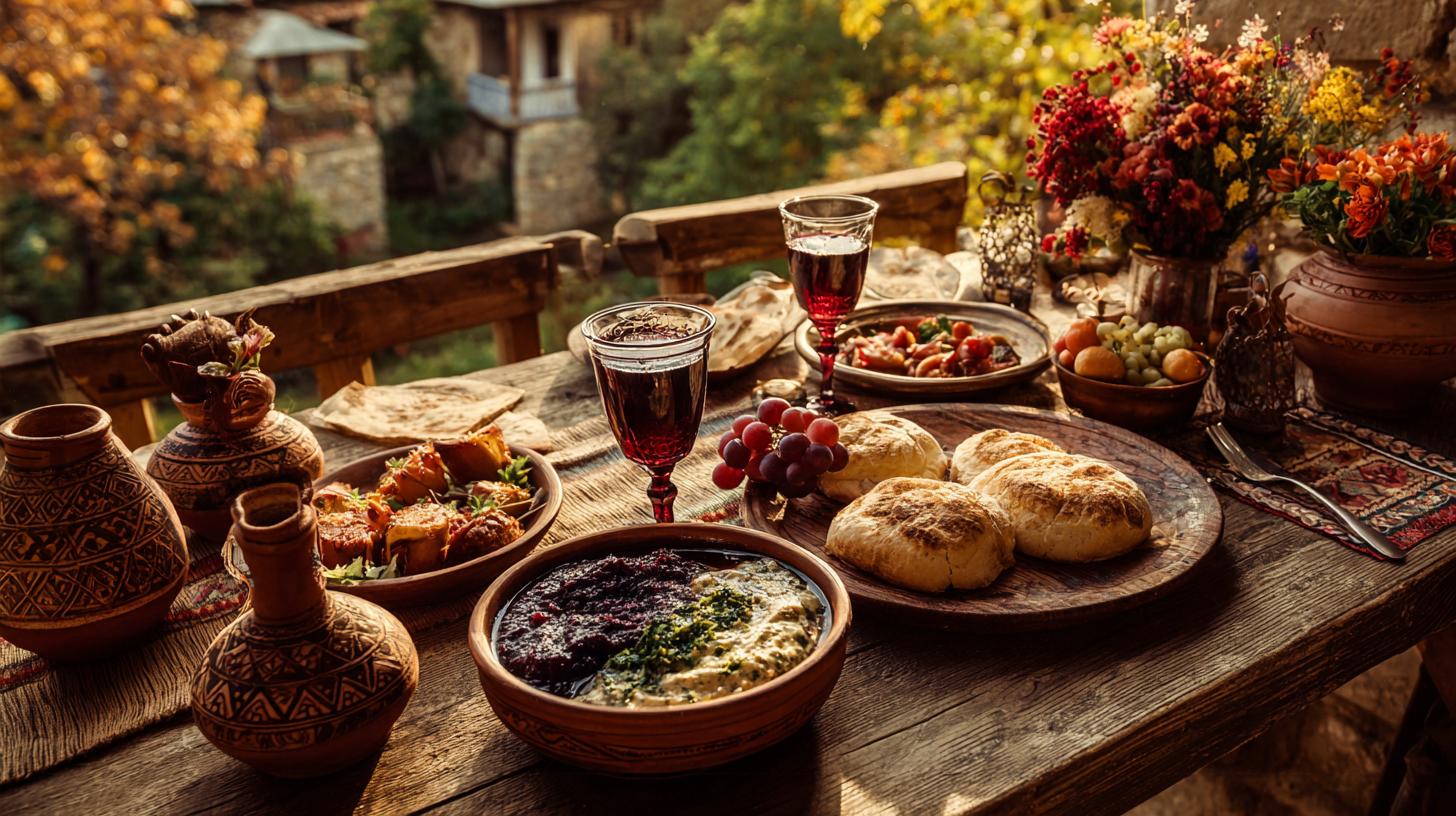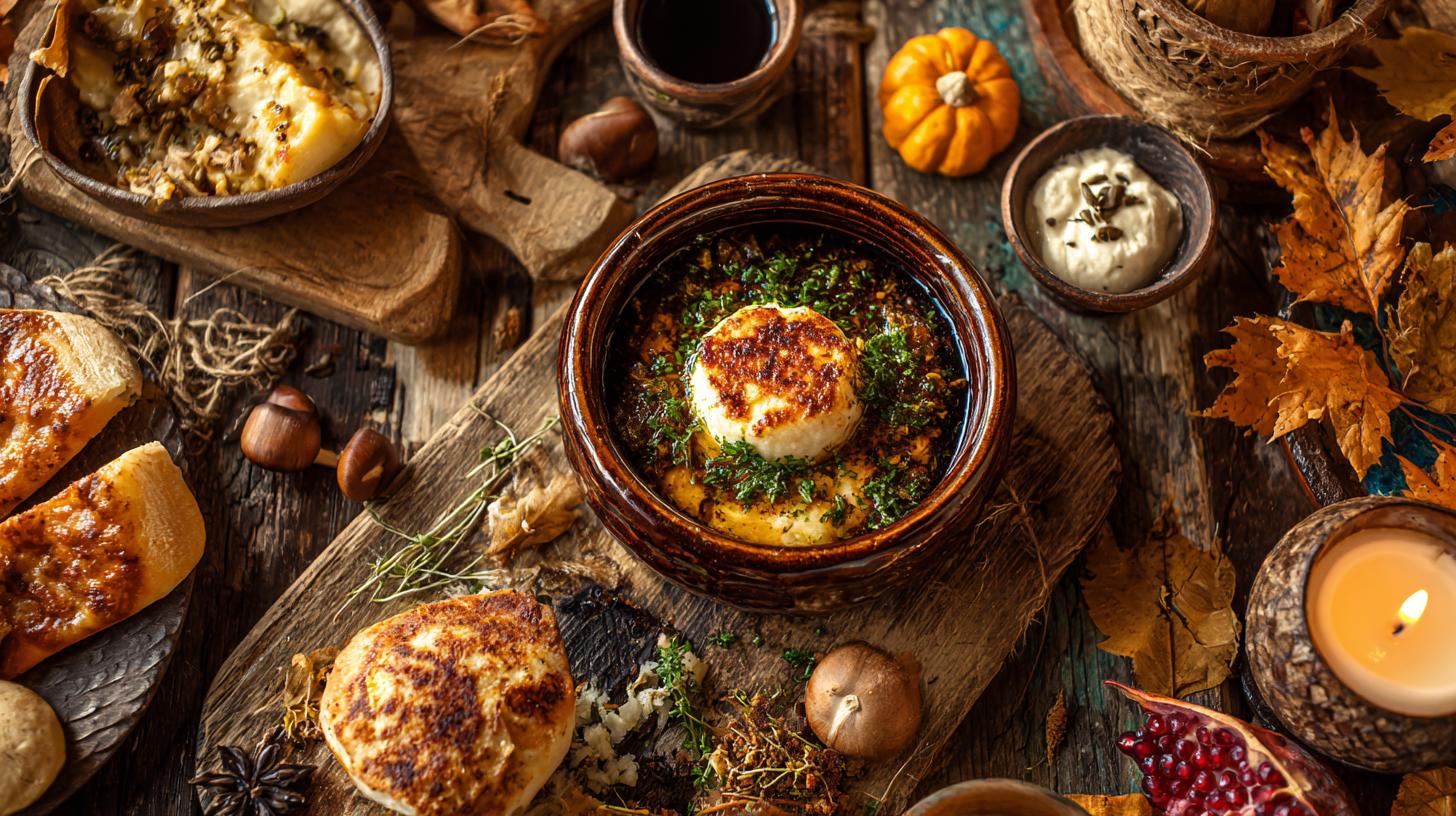As the leaves turn golden and the air becomes crisp, our thoughts naturally drift toward comfort food that warms both the body and soul. Autumn invites a shift in the way we eat—favoring heartier meals rich in spices, fresh produce harvested at this time of year, and a sense of communal dining that brings people together as the days grow shorter. Georgian cuisine, with its unique blend of flavors, textures, and traditions, fits seamlessly into this seasonal rhythm. If you have ever wondered why Georgian cuisine is perfect for autumn dinners, this article will take you through the multiple reasons that make this culinary tradition an ideal choice for the cooler months.
The Seasonal Harmony of Georgian Ingredients
Georgian cuisine reflects the country’s fertile landscape and diverse climate, boasting a variety of ingredients that peak during the autumn harvest. Root vegetables, squash, walnuts, pomegranate, and fresh herbs are staples found abundantly in Georgia’s autumn markets. These ingredients naturally complement the cooking styles that define Georgian meals.
For example, walnuts play a pivotal role in Georgian cooking, appearing in sauces, fillings, and salads. Autumn is the season when walnuts are freshly harvested, offering a rich and creamy texture that enhances many traditional dishes. Pomegranates, too, which are emblematic of Georgian kitchens, arrive in their prime during autumn. Their vibrant seeds add an enjoyable crunch and a sweet-tart burst of flavor that enliven stews, salads, and even desserts.
Table: Popular Autumn Ingredients in Georgian Cuisine
| Ingredient | Usage | Seasonal Significance |
|---|---|---|
| Walnuts | Used in sauces (such as satsivi), fillings, salads | Freshly harvested in autumn, adds richness |
| Pomegranates | Salads, garnishes, desserts | Available fresh, adds color and flavor |
| Butternut Squash | Soups, stews, roasted vegetable dishes | Abundant in autumn, provides sweetness and texture |
| Root Vegetables (Carrots, Beets, Turnips) | Roasted sides, soups, stews | Harvested in late summer and autumn |
| Fresh Herbs (Cilantro, Parsley, Dill) | Garnishes, sauces, salads | Preserved and used fresh for bright flavors |
These ingredients not only taste exceptional but also offer nutritional benefits that are particularly valuable during colder months, including healthy fats, antioxidants, and vitamins that help keep the immune system strong.
Georgian Cooking Techniques That Embrace Warmth and Comfort
Why Georgian cuisine is perfect for autumn dinners also comes down to its cooking methods, which prioritize slow cooking, simmering, and baking in ways that develop deep, comforting flavors. As the temperature dips, the idea of a steaming pot of food that has been lovingly tended to over time becomes especially appealing.
Traditional Georgian dishes often involve recipes that slow-cook meats with nuts and spices in thick sauces, generating complex tastes and tender textures. This technique is perfect for autumn since it uses seasonal ingredients while creating dishes that fill your home with delightful aromas.
Take for example, the iconic dish of Kharcho, a hearty beef soup enriched with walnuts, tomato paste, fresh herbs, and rice. This warming soup provides nourishment and a touch of spice to invigorate chilly evenings. Another notable dish is Chakapuli—a stew made from lamb or veal, combined with tarragon, green plums, and white wine—exemplifying how Georgian cooks use seasonal ingredients to produce a deep, satisfying flavor profile.
List: Cooking Methods That Suit Autumn Dinners in Georgian Cuisine
- Slow cooking and simmering in pots and cauldrons
- Baking in traditional stone ovens (tone)
- Stuffing and baking vegetables like peppers and eggplants
- Stewing meats with fresh herbs and nuts
- Preparation of thick, creamy sauces for warming dishes
These methods allow for the incorporation of autumn’s bounty in ways that maximize comfort and satisfaction, making Georgian cuisine a natural fit for the season.
Spices and Flavors Tailored to Autumn Palates
A crucial reason why Georgian cuisine is perfect for autumn dinners lies in its flavor profile. Georgian dishes tend to balance earthy, tangy, and mildly spicy notes, combining spices and herbs that enhance the natural taste of in-season ingredients without overwhelming them.
Georgian cuisine employs herbs like cilantro, parsley, and dill liberally, which add brightness to heavy or rich dishes. Additionally, spices such as blue fenugreek (utsko suneli), coriander, and marigold powder give a unique, mildly warm aroma that is not too sharp but perfectly suitable for cooler weather.
The use of fresh garlic and onions is common and contributes to layering flavors that feel hearty but not overly heavy. Typical Georgian spices are often combined with sour components—such as pomegranate juice, sour plum sauce (tkemali), or vinegar—that add necessary acidity to balance rich meats and nuts.
Table: Common Georgian Spices and Their Autumn Appeal
| Spice/Herb | Flavor Characteristics | Role in Autumn Dishes |
|---|---|---|
| Blue Fenugreek (Utskho Suneli) | Earthy, slightly sweet, mild bitterness | Adds complexity to meat stews and sauces |
| Coriander | Warm, citrusy undertones | Enhances soups, stews, and vegetable dishes |
| Marigold Powder | Slightly bitter, herbal | Used in spice blends to deepen flavor |
| Garlic | Pungent, aromatic | Infuses savory warmth in sauces and meats |
| Sour Plum Sauce (Tkemali) | Tart, fruity | Balances richness in meat dishes |
This balance of spices and their aromatic qualities makes Georgian cooking exceptionally well-suited to the palate’s cravings during autumn. The flavors feel layered, interesting, and fulfilling without being overly heavy or greasy.
Shared Meals: The Social Side of Georgian Autumn Dinners
An important yet often overlooked reason why Georgian cuisine is perfect for autumn dinners lies in its role as a communal experience. Georgian dining culture revolves around the “supra,” a traditional feast where friends and family gather around a table laden with multiple dishes, sharing food and stories late into the evening.
Autumn, with its longer nights and cooler weather, naturally encourages indoor gatherings. The communal nature of Georgian food, with large platters of food designed for sharing, creates a warm, inviting atmosphere that transforms a simple meal into an event.
This style of eating encourages trying a variety of dishes, from hearty meat-based stews to fresh vegetable salads, pickled accompaniments, and fermented bread like mchadi. It also includes wine, as Georgia is one of the world’s oldest wine-producing countries, and wine pairing plays an essential role in the traditional supra experience.
List: Elements of a Georgian Autumn Dinner Supra
- Multiple shared dishes including hot and cold options
- Fresh and preserved vegetables and herbs
- Rich meat dishes and nut sauces
- Freshly baked bread and traditional cornbread (mchadi)
- Local wines and drinks adding depth to dining
- Toasts and lively conversation led by the Tamada (toastmaster)
This interactive dining experience not only satisfies hunger but also enriches social bonds—something particularly meaningful during the autumn months when days grow shorter and people seek comfort beyond the plate.
Popular Georgian Autumn Dishes That Capture the Season

Exploring specific dishes reveals why Georgian cuisine works so well for an autumn dinner, offering warmth, richness, and balance. Here are some notable traditional dishes commonly enjoyed in autumn.
Khachapuri with Seasonal Twists
Khachapuri—cheese-filled bread—is a staple of Georgian cuisine. While it is enjoyed year-round, during autumn it often appears with added fillings such as roasted pumpkin, mushrooms, or herbs that highlight the season’s bounty. The bread and melted cheese provide satisfying warmth, while the seasonal fillings keep the dish fresh and intriguing.
Badrijani Nigvzit (Eggplant with Walnut Sauce)
These tender eggplant slices rolled around a spiced walnut paste present a fantastic balance of texture and flavor. Walnuts are at their best in autumn, making this cold appetizer a common feature of seasonal tables. The richness of walnuts and the mild bitterness of eggplant complement the cooler weather and signals the start of the heartier food season.
Pkhali (Vegetable-Walnut Pâté)
Pkhali is a collection of vegetable-based spreads using ingredients like spinach, beets, or cabbage mixed with ground walnuts, garlic, and herbs. Often garnished with pomegranate seeds during autumn, pkhali offers a fresh yet nutrient-dense option that balances heavier dishes on the table.
Chakapuli
As mentioned earlier, Chakapuli is a stew enjoyed mainly in spring and autumn when tarragon and green plums are available. Its tender meat cooked in fragrant broth with sour notes provides a warming meal perfect for chilly nights.
Ostri (Spicy Beef Stew)
Ostri is a tomato-based beef stew seasoned with garlic, chili, and herbs. Its deep flavors and spicy notes make it a soul-warming dish ideally suited for the autumn season.
List: Other Seasonal Staples
- Mtsvadi – Georgian shish kebab, often with autumn-rooted marinades
- Chikhirtma – Sour chicken soup that soothes the body
- Kharcho – Beef and walnut soup rich in spices and herbs
- Homemade preserves and pickles – complements to heavier dishes
These dishes reflect the diversity and adaptability of Georgian cuisine, making it perfectly aligned with autumn cravings for heartiness, warmth, and deep flavor.
The Role of Georgian Wine and Drinks in Autumn Dining

No exploration of why Georgian cuisine is perfect for autumn dinners is complete without mention of its deep wine culture. Georgia has an ancient tradition of winemaking that dates back thousands of years, and wine is inseparable from its food culture.
During the autumn harvest period, new vintages are celebrated with excitement, and the wines naturally accompany the rich dishes characteristic of this time. Georgian wines, often produced from indigenous grape varieties like Saperavi (red) and Rkatsiteli (white), carry bold profiles with enough acidity and tannins to complement robust dishes.
Table: Georgian Wine Varieties Recommended for Autumn Dinners
| Wine Variety | Color | Flavor Notes | Food Pairing |
|---|---|---|---|
| Saperavi | Red | Rich, dark berry, earthy, balanced tannins | Red meat stews, spices, nut-heavy dishes |
| Kindzmarauli | Red | Sweet, fruity, mild tannins | Spiced meats, slightly sweet dishes |
| Rkatsiteli | White | Crisp, acidic, citrus, fresh | Light soups, vegetable dishes |
| Mtsvane | White | Floral, fruity, vibrant acidity | Fresh salads, seafood (when included in menus) |
In addition to wine, traditional Georgian drinks like chacha (a grape-based spirit) are sometimes enjoyed during festive autumn gatherings, helping to create warmth and conviviality.
Why Georgian Cuisine Suits Modern Autumn Dining Trends

Finally, considering current trends in dining and nutrition, Georgian cuisine’s harmony with autumn meals becomes even clearer. There is growing interest worldwide in seasonal, locally sourced ingredients, slow cooking, and shared dining experiences—all elements at the heart of Georgian culinary tradition.
Georgian dishes typically avoid heavy reliance on processed foods and use natural, fresh ingredients. They emphasize balance, with vegetables and nuts complementing meats and starches. This fits well with contemporary preferences for wholesome, mindful eating, particularly in autumn when people seek foods that are both nourishing and comforting.
Moreover, the convivial nature of Georgian dining aligns with the increasing emphasis on connection and social interaction around meals, which many find especially valuable as the year winds down.
Exploring Georgian cuisine in autumn provides a rich culinary adventure that satisfies body and spirit, makes the most of seasonal produce, and invites shared memories around the table—explaining clearly why Georgian cuisine is perfect for autumn dinners.